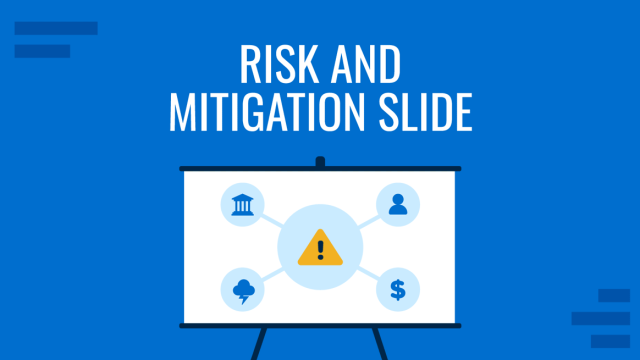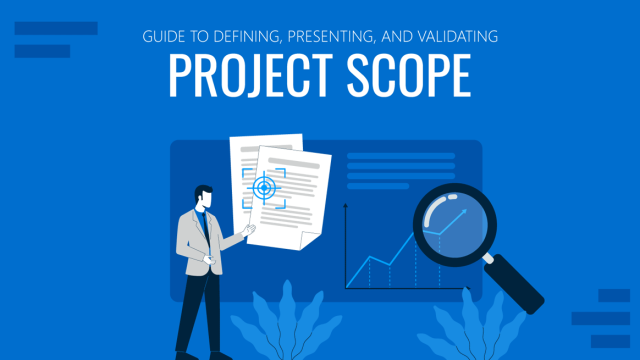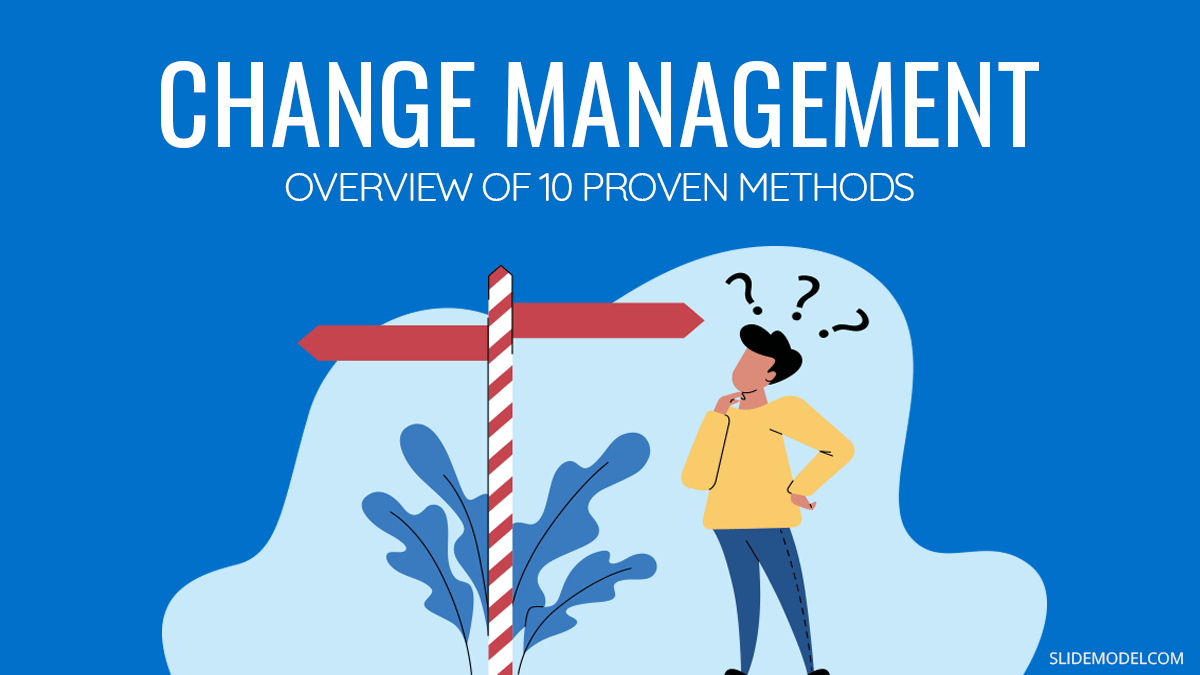
Any organization which wants to remain up-to-date with the evolution of market conditions, customer requirements, or service delivery cannot elude the inevitability of embracing change. Though painful, change is necessary and can be hard to implement across an organization. This is particularly the case when a radical shift in procedures is to be implemented. Effective change management is essential for the smooth and successful transition of adopting the new and discarding the old. We have created a list of 10 proven change management models that organizations can use for effective change management.
What is Change Management?
Change Management (CM) is a term used for various approaches used for preparing and supporting change organizations. Several change management models are used for preparing and helping organizational teams and individuals implement, adapt, and manage new technology, processes, acquisitions, mergers, etc.
Change management can include introducing new technology, changing to a new production process to reallocating resources, restructuring departments, and even managing a newly acquired asset.

Introduction to Change Management Models
Many of the change management models during the 1960s come from grief studies. First, the similarity between grieving from health-related issues was compared with the employees’ mourning during a phase of job-related transitions. This was later built upon and modified by various individuals, including theorist Everett Rogers, Julien Phillips, who worked as a consultant at McKinsey & Company, Jeffrey Hiatt, John Kotter, and others. Below is an overview of 10 famous change management models that organizations have used for effective change management.
1. Change Management Foundation and Model
Change Management Foundation consists of four stages. These include determining the need for change, preparing and planning for change, followed by the implementation phase, and sustaining it.
2. John Kotter’s 8-Step Process for Leading Change
The Model
Dr. John P. Kotter developed the 8-step process for leading change. He was also the founder of the management consulting firm Kotter International. His 8-step model included creating a sense of urgency, building a guiding coalition, forming strategic vision and initiatives, enlisting a voluntary army, removing barriers through enabling action, generating short-term wins, sustaining the acceleration and institutional change.

The Method
Sense of Urgency
If a team has a sense of urgency, this model will acquire adequate momentum and traction for teams to get on board. The first step is to get the core team ready for deployment, and they will expand this enthusiasm for the rest of the team.
Build a guiding team
It’s time to get the stakeholders interested in the change. These stakeholders should be leaders in different organization ranges, where people can feel related and want to collaborate.
Develop a vision
Based on the values, it’s essential to lay down the fundamental changes to do and how to get there on paper. The language and phrasing must be translatable and straightforward across the board.
Communicate for buy-in
People must know about the change process happening, but they need to be convinced to collaborate. Every level of the organization must be in this together. During this part of the process, it’s important to hold horizontal meetings where feedback is the main issue on the table.
Empower Action
Employees need to understand not just that change needs to happen but why. Ensure you find the required tools and skills to empower everyone to be a part of this change.
Short-term wins
For the change process to be efficient, it’s essential not just to play a long-term game. Instead, ensure you can map and measure short-term wins and acknowledge the people and the teams making it happen. The initial hype of change is contagious; what is really complex is to keep that energy going.
Sustain acceleration, Never let Up
The changes have been done, and now we need to get the acceleration going. It’s vital to keep track of all the wins and the failures, improve as we go, and, when necessary, reroute with new objectives to make sure you are on the right track.
Incorporate change in the culture
It’s time to document and set those changes deep in company culture. At this stage, it’s essential not to be shy about what has been done so far and how this has impacted the organization and keeps everyone motivated.
Pros of Kotter’s 8 Step Model
This model’s positive energy creates the beginning, allowing for the momentum that can make any change happen. This way, teams will be easily motivated to incorporate new routines and processes quickly.
Con’s of Kotters 8 Step Model
Feedback is essential in change management. Unfortunately, this model is thought out as a top-bottom approach, meaning that it seeks to be cascaded from upper levels, not considering the profound needs that might arise from lower organizational levels.
3. The Plan-Do-Check-Act Cycle
Created by Dr. Williams Edwards Deming, the Plan-Do-Check-Act Cycle (PDCA) comprises choosing between which changes to implement. PDCA or the Deming cycle is basically a cycle for control and improvement of products and processes. The model prescribes looking into four factors for this purpose. These include planning change by picking goals and strategies. The second step includes implementing the plan, followed by checking results to understand how your goals, strategies, and plans are working. This is the phase where data can be analyzed and compared to the expected outcomes to understand if desired goals are being met. The final step is to ‘act’ or adjust your process to improve it.
This change management framework might be helpful for implementation on a small scale before the changes are implemented across the organization.
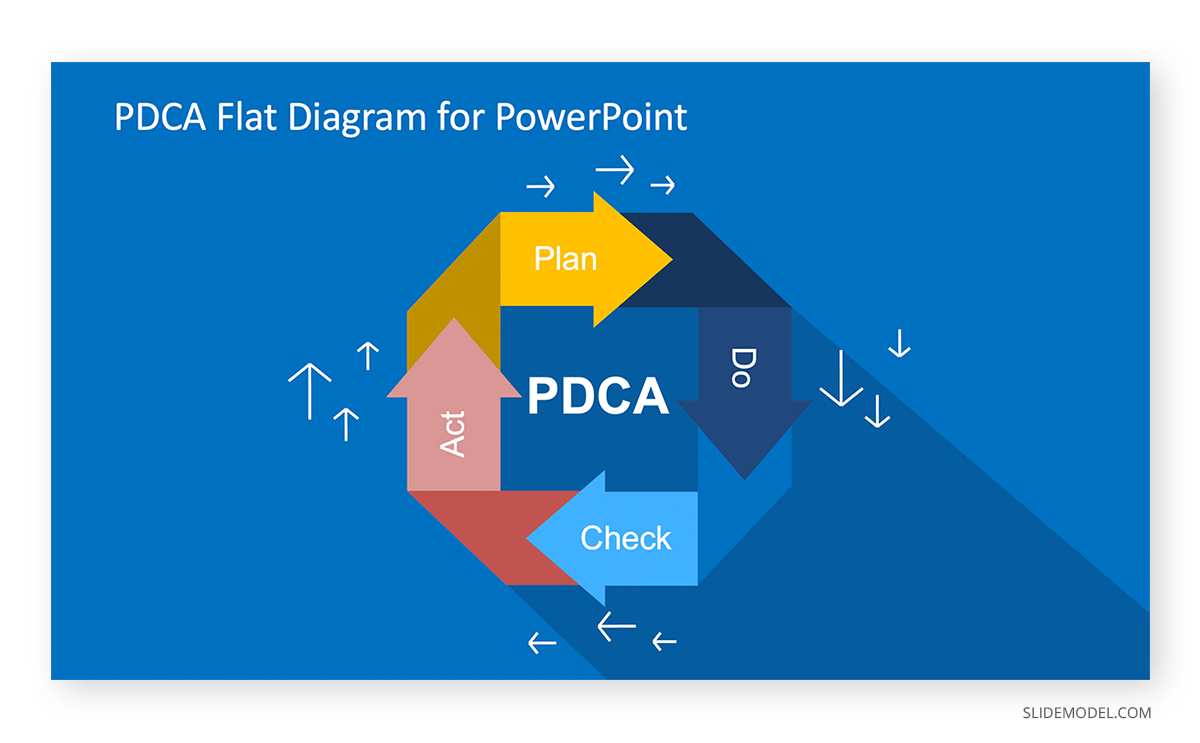
4. The Prosci ADKAR Model
The Model
Developed by Jeffrey Hiatt, this model focuses on the people associated with the change with a bottom-up approach. Instead of working linearly, the ADKAR model represents various goals that should be reached for successful change management. Hence, the ADKAR acronym stands for awareness, desire, knowledge, ability, and reinforcement.
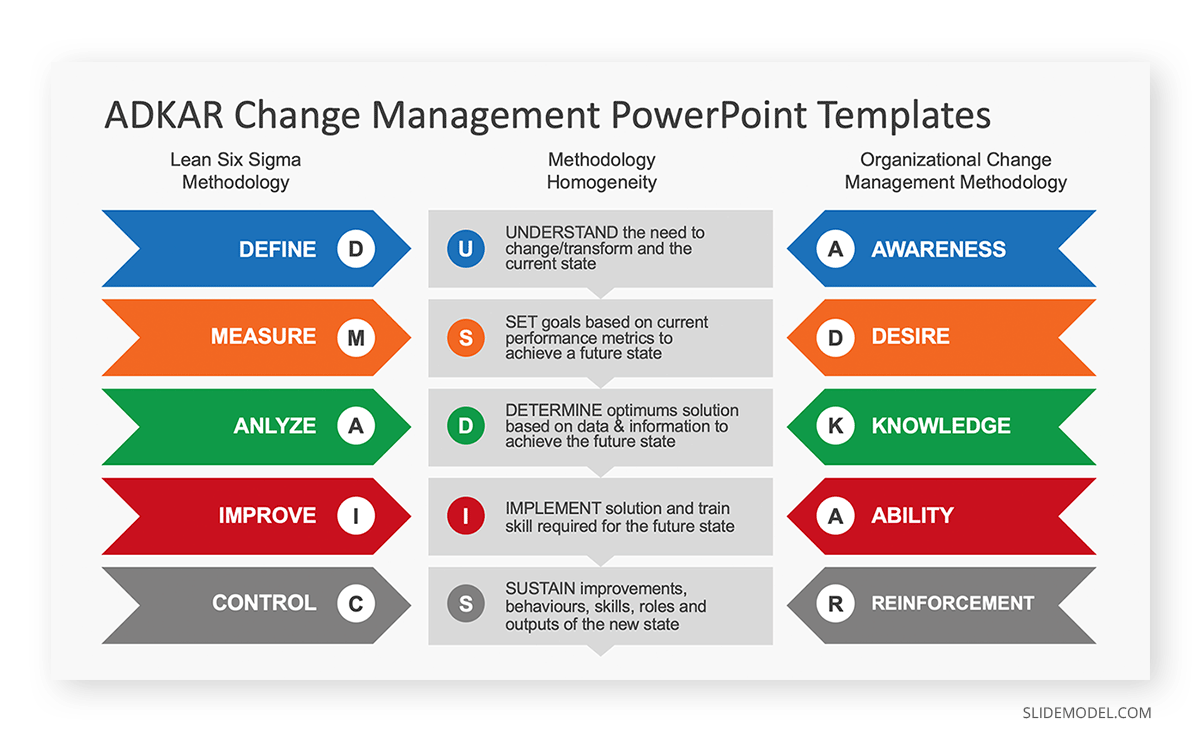
The Method
Awareness
Creating awareness requires sending out a list of requirements to the people involved but providing all necessary understanding to get them on board. As well it’s vital to justify not only why they will happen clearly but also how it can affect them to inspire positive thoughts towards change.
Desire
Inspiring a want for change is not easy, so it’s important to define if this need and want for change will come from the emotional or logical aspects. It’s not just about convincing others but truly inspiring the desire for change.
Knowledge
By this point, you have already talked to your team about the changes needed and inspired the need; therefore, it’s crucial to help them understand how this change will happen. Ensure you are thorough and explain what steps will be taken and process’ will be implemented
Ability
Not to be confused with knowledge, the ability has to do more with the expertise acquired with time, how masterful a person becomes when dealing with a process, and change. During this phase, it’s important to document what needs to be learned and increase employees’ ability.
Reinforcement
As change can commonly bring resistance, it’s important to check in during this phase with a set of rewards that can be put into place for those who are quickly adapting to the changes.
Pro’s of the ADKAR Model
Incremental changes are easy with this model, mainly because it has a bottom-to-top approach that can accelerate transformation as it’s moving forward in the organization. In addition, the fact that it’s focused on the people more than on the process itself makes collaboration easier.
Con’s of the ADKAR Model
If you’re seeking a model that works with change large scale, ADKAR might not be the best option. Its style makes it more challenging to drive change when the number of people involved is extensive.
5. McKinsey 7-S Model
The Model
McKinsey’s 7-S Model provides seven elements to be assessed regarding how they affect each other and how coherent the company is when implementing change. This somewhat makes the model complex but provides an advantage when you are not 100% sure of the starting point. The seven elements in the McKinsey 7-S model include three hard elements, i.e., strategy, structure, and systems, easier to identify and influence by the management. The remaining four soft elements are affected by company culture and can be harder to implement. These include shared values, style, staff, and skills.
For more information, check our article about McKinsey presentations.
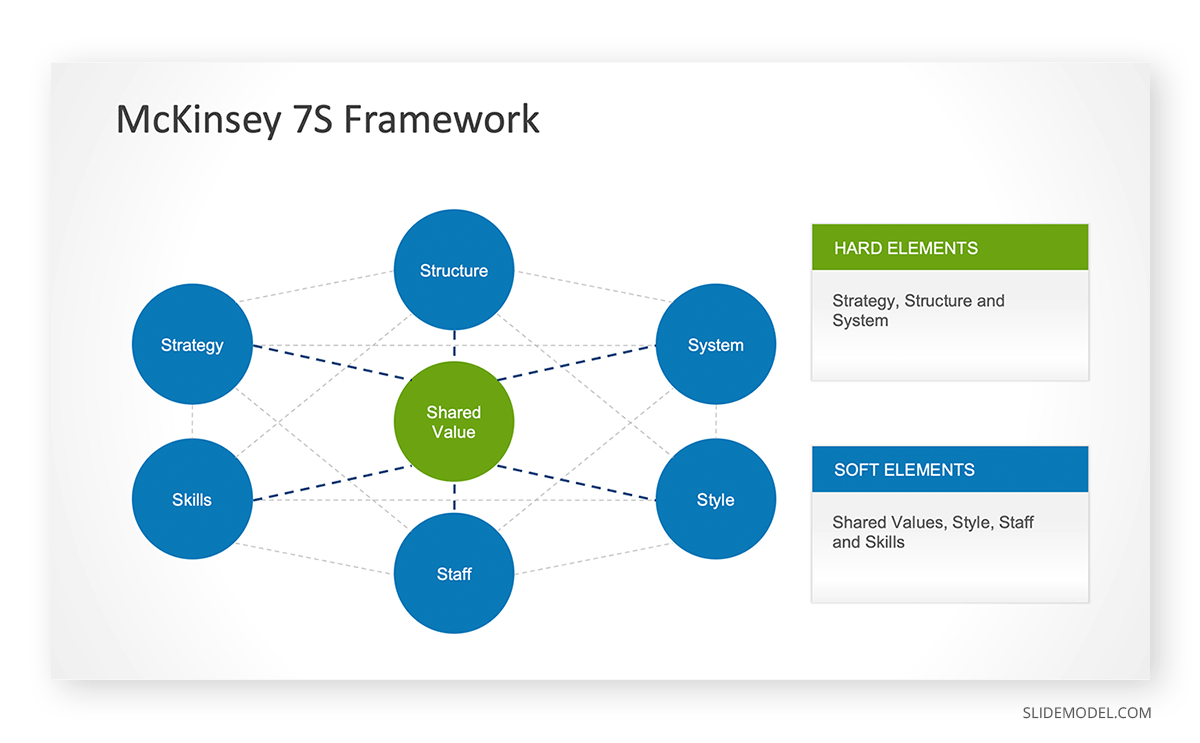
The Method
Strategy
The first step of this model is evaluating the strategy: what are your objectives, what steps are you taking to reach them, how are you adapting to changing times. Asking hard questions like this will begin a conversation that will generate an honest approach to what the organization has been doing so far.
Structure
This is your organizational structure, and it’s easy to portray as it’s pretty tangible; in a medium organization, you should still be able to track down all positions. If you are working in a larger group, you might want to track your team only. Ask yourself questions about the team’s hierarchy, how the team collaborates, and how communication flows from one end to another.
Systems
Now that we have clarity about the purpose and the people, it’s crucial to analyze the process and how they are being managed. Pose the following questions: What are the core process’? How are they used and updated? Who are the key players in managing them?
Shared values
This part of the exercise can be tricky; values can mean different things to different people and work in a particular matter in diverse contexts. If you are working with the whole organization, the values might differ from those specific to each team; take this into account. You can ask yourself questions about which values are currently known or how the company culture affects the team members.
Style
This “s” seeks to understand and reflect mainly leadership styles, taking into account how performance can be affected by the ones who are leading. Here, some important questions to ask are: Is the leadership style about collaboration? What styles are more active? Do you have leaders or managers in your organization.
Staff
The title of this section is pretty self-explanatory: who are the people in each one of the roles? What skills are currently present in your team? Have all necessary roles been filled?
Skills
We have asked questions about the staff and what skillsets you currently have in your team, and now we need to assess future skills you need your team to possess or acquire. So this is an excellent time to ask: Does your team have all the skills they need? Which skills are missing?
Pro’s of the McKinsey 7-S
This complex and holistic model allows for an extensive assessment of almost any industry. It goes deep into all the layers allows for a clear review of what is doing good and what needs improvement.
Con’s of the McKinsey 7-S
If the organization is huge, this model might take too long in providing results; due to the complexity of the McKinsey 7-S, it’s more suitable for smaller companies or teams.
6. Kübler-Ross Change Curve
The Model
The Kübler-Ross Change Curve is also known as the five stages of grief and has an important relation to the emotional process of change management. The model was developed by psychiatrist Elisabeth Kübler-Ross and acknowledged the pain that can be caused due to change, leading to a five-stage grieving process. First, change is met with denial and anger, followed by bargaining and depression until acceptance is reached. Next, employees can go through a similar approach. The model can be used on a small scale to connect with employees to understand their issues and outline steps for achieving set goals related to change management.
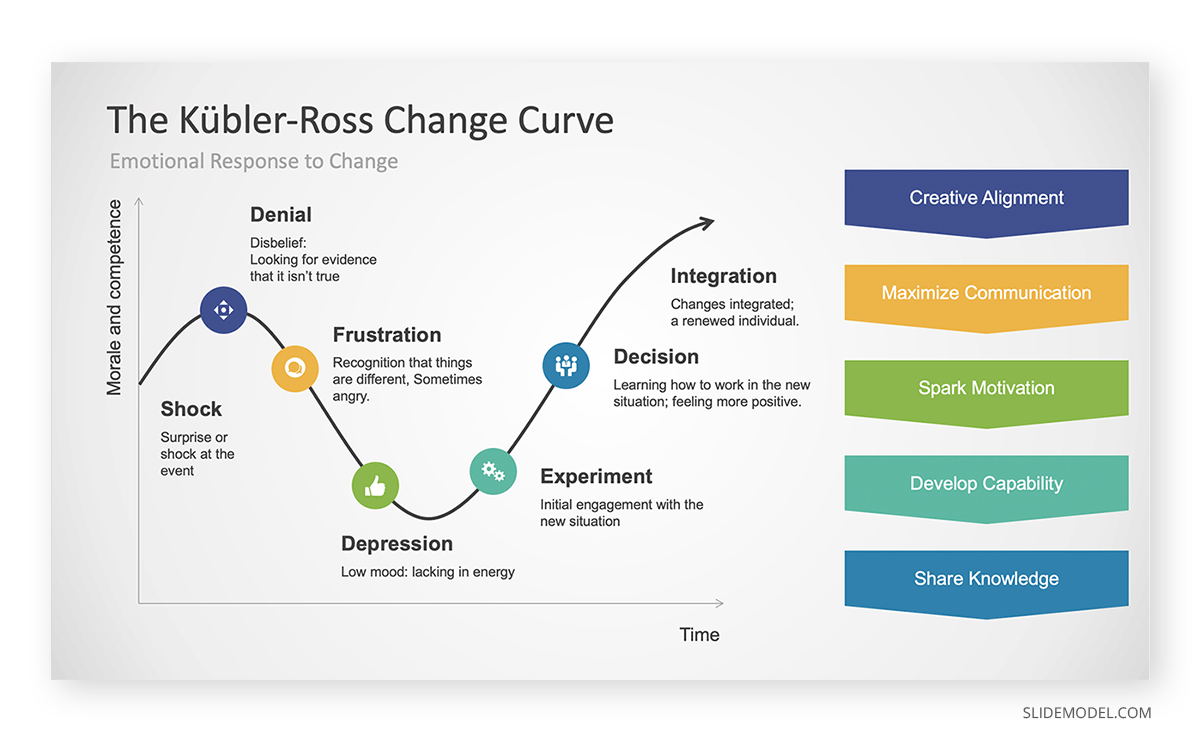
The Method
Denial
Your team might be facing a denial regarding change and find it difficult to see the road ahead. Therefore it’s essential to guide your team through this stage with few and essential information. It’s crucial to start this phase gradually and keep the communication lines quite open to overwhelm no one.
Anger
Change might completely disrupt people’s routine, causing frustration and, later on, anger. This is a natural process, and you shall be prepared for it, and overall with an action plan to counter it positively. Also, watch out for your more susceptible employees and work around their emotions to learn how to navigate them.
Bargain
Your team will be looking for ways to bargain; however, the transition has been set in motion for significant reasons. Therefore, make sure you communicate properly, not just what changes will happen but also why, and be as transparent as possible about how it affects all the team members. Also, work on listening to feedback, as interesting ideas can also arise.
Depression
Even though this is a strong term to use, it is precisely the reaction some of your employees might experience. Letting go of old ways and learning new ones might be a challenge that can take an emotional toll. Try to limit the frictions in your team and find ways to reward those who are implementing those changes to keep up the general morale.
Acceptance
This is a new stage of positivity and celebration; you are on the verge of starting a new process with your team. Work on the positive side of how these changes affect your team and find silver linings for the group or individually.
Pro’s of the Kübler-Ross Model
The emotional aspects of change are often overlooked; in this model, it’s all about it. Understanding and managing the emotional response during change can allow planning that can take definite pain points away
Con’s of the Kübler-Ross Model
Humans can be unpredictable, especially in regards to emotional responses. It is possible that this model can be quite effective with some people, however not be your team’s rule.
7. Satir Change Model
The Model
Like Kübler-Ross Change Curve, this model too looks at the emotional aspects of change affecting employees. There are five stages in the Satir Change Model to monitor the emotions of employees. For example, the late status quo is deemed the first symptom, interrupting a flow of work or daily life. This is followed by resistance and chaos. These can be deemed as the two emotional consequences for dealing with change. The final two stages include integration and the new status quo. The final stage implies that people eventually adapt to change, and the status quo is achieved again under the new reality.
While the model does not offer a roadmap for adapting to change, understanding the Satir Change Model can help understand how employees deal with change and how they can be facilitated to deal with the transition process emotionally. The model can help address lack of communication, confusion, and resistance to change in an organization.
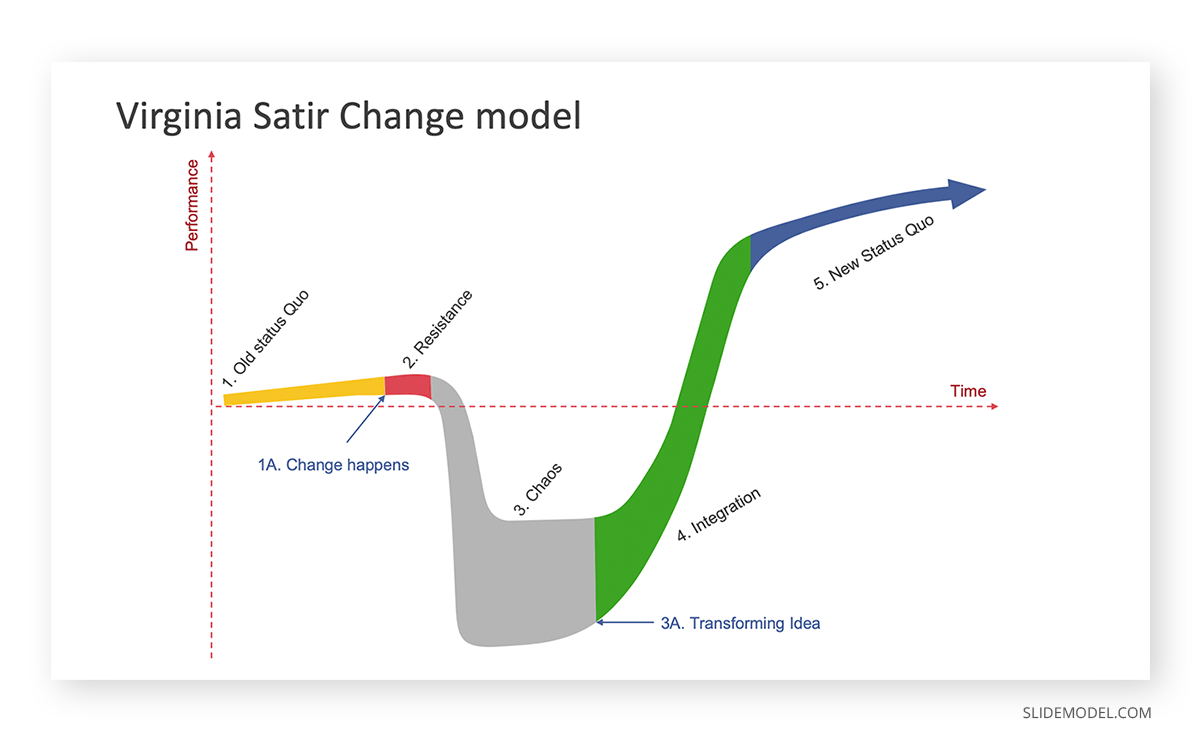
The Method
Late Status Quo
This phase is where your team currently is, everyone is in their comfort zone an results are quite consistant, no change has been introduced.
Resistance
As soon as the first glimpse of change is introduced, resistance will also show up. During this phase, some employees may face denial or start neglecting essential tasks or duties. Therefore it’s important to get them to commit to the changes happening.
Chaos
Yes, it does sound intense, and it is; however, it’s not the end; on the contrary it’s all up from here. Pay attention to your team’s feedback and work with them on bringing everyone up to speed with commitment and communication.
Integration
As you sail through new waters, your team will become motivated and start accepting and implementing change. It’s important not to drop the ball at this point and continue to support any problems that can arise.
New Status Quo
Change has not only happened, but a new process reigns at this point. The performance will start to pick up, and it’s a perfect moment to realign and verify all procedures are being followed and documented as needed.
Pro’s of Satir’s Model
Taking into account that this model is similar to Kubler-Ross, we can talk about a similar effect. However, this model allows for even better planning because it’s much more business and performance-oriented.
Con’s of Satir’s Model
This model tends to be unspecific as it’s very subjective on when and how each stage will happen. You might need to support with strong measurement.
8. Bridges’ Transition Model
The Model
This is another model which looks at the emotional side of how change affects employees. The model does not focus on the change process but on how individuals are affected by the change. The model starts with letting go of fear, uncertainty, anger, sadness, etc. The resentment eventually reduces, leading one to the neutral zone. This is the bridge between the old and the new. In the end, people embrace change.
The model breaks down the process of transition into three stages. The first stage includes ending, losing, and letting go. Then people reach the neutral zone. Finally, they can start a new beginning.
The Method
Ending, Losing, Letting Go
Change generates feelings, and not always they are easy to cope. However, depending on the importance and impact of the change happening, people can mourn and have resistance to what will be.
During this phase, communication is everything, as it allows the exploration of emotional responses like fear, anger, and denial, all-powerful emotions. However, it’s also essential to have a support system revert to a negative moment in the organizational story.
The Neutral Zone
This phase is not so neutral. It can be a bit low, as your team will be adapting to change, and you can even see productivity lower. Focus on understanding what is affecting your employees and providing accurate feedback to give them the tools they might need to move forward, including celebrating small wins.
The New Beginning
The most challenging part is that everyone in the organization or team will have come to terms with the change and will be much more receptive to the new process. Rewarding and recognizing can also play a huge role here, as it might be the best way to reinforce why goals have been put into place.
The Pro’s of the Bridges Transition Model
Most management processes don’t take into account individual emotions, and the Bridges Transition Model does. This is positive because it reduces the gap between organizational levels, increasing cooperation.
The Con’s of the Bridges Transition Model
This model lacks a specific set of steps to follow; this can be confusing and difficult when navigating a situation full of feelings.
9. Lewin’s Change Management Model
The Model
Lewin’s model is quite popular because it’s simple enough to use and be understood by the general public. It consists of 3 main steps that resemble water with a metaphor of freezing and unfreezing to analyze the process. Hence, the three stages of the model include unfreezing, change and refreeze.
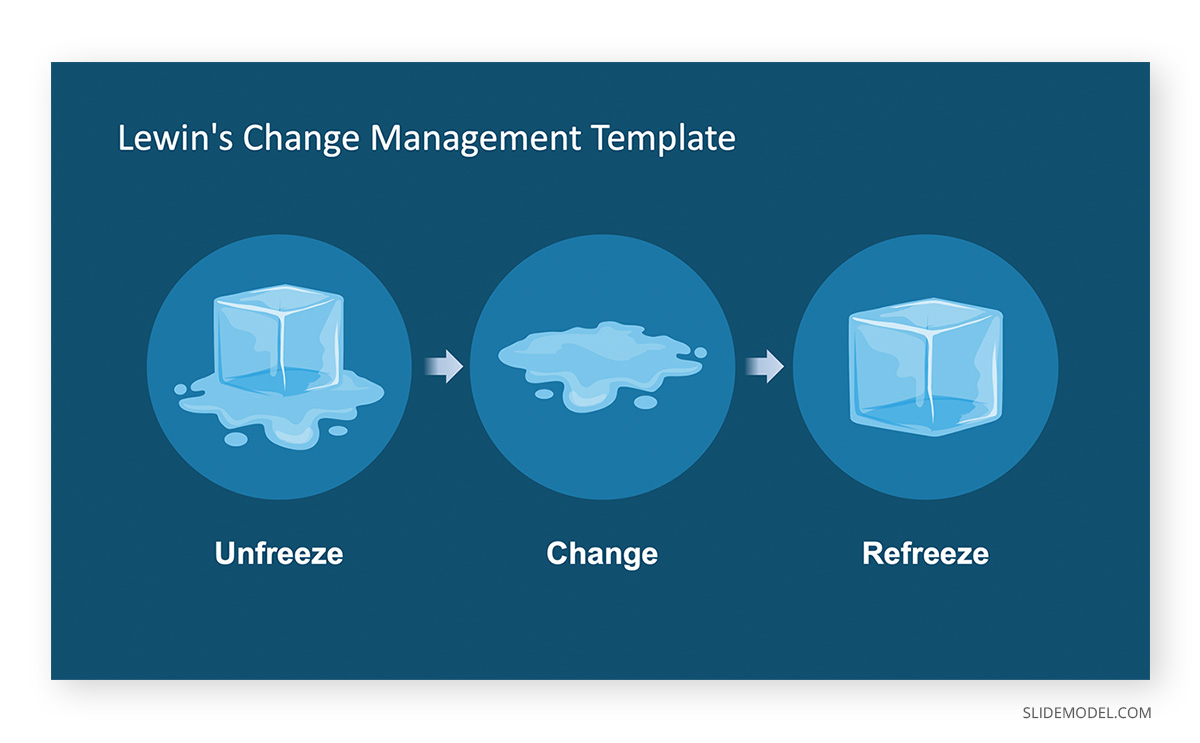
The Method
Unfreeze
The model implies that you must unfreeze and analyze your process in the first stage for improvement to be understood with ease by everyone. When “unfreezing” a process, it’s easier to analyze each step and start removing any previous bias’ that might exist. This will also be helpful to start getting your team ready to assume the change that will be coming forward and eliminate resistance.
Change
This is followed by change, which is represented as an ice-cube melting and allows the transition phase. Once this phase has begun, it’s time to start making any changes to improve the process. Define what is required to help everyone be on board, extra training, learning process, and mentorship. This is a good time also to share bilateral feedback to indeed all the needs that arise.
Refreeze
Once the change has been tweaked and adjusted according to need, the new status quo should undergo refreeze; the intention is that by this point, new habits start forming. This part is crucial, so it can also be relevant to create a reward program for people who follow the process.
Pro’s of the Lewin Change Model
Since this model has only three main steps set up in the freezing metaphor, it’s easy to understand and relate to many people across cultures. Also, Lewin’s model is focused on behaviors, so it’s straightforward to implement.
Con’s of the Lewin Change Model
Precisely because of its simplicity, it’s not a model that can consistently be implemented, and it can lack the details required for specific organizations. Some see it as an older model that might not adapt easily to our fast-paced current times.
10. Maurer 3 Levels of Resistance and Change Model
Unlike other models discussed in this article, the Maurer 3 Levels of Resistance and Change Model focuses on not how change occurs but why it fails. It identifies three levels of resistance, including ¨I don’t get it¨, which is when people are confused regarding the change. ¨I don’t like¨it is the second level when people emotionally react to change, which can exacerbate to level 3, i.e. ¨I don’t like you¨ or feelings of mistrust.
Reasons for Failure of Change Management
As Maurer 3 Levels of Resistance and Change Model explains, change management can fail due to confusion, frustration, resistance, and mistrust among employees. Change management can fail when employees are rushed into change without proper transitions or training. Similarly, when employees aren’t convinced of the need for change, they can consider it unnecessary or take it as a burden.
When organizations fail to win their employees´ trust, train them properly to adapt to change, don’t have measurable goals or fail to make use of data along the transition process, change management fails.
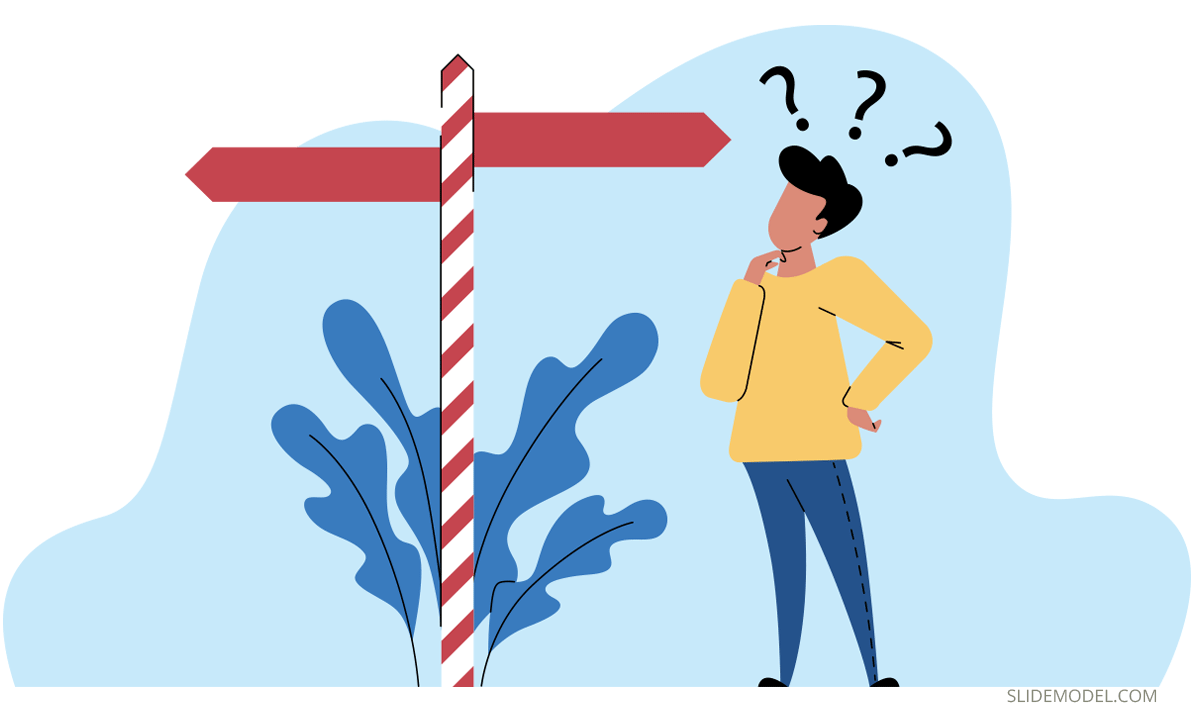
What is Needed for Successful Change Management?
Change is often met with resistance when organizations don’t plan and foresee possible issues that it can bring. It is not only incompetent employees who might resist change. An organization’s best performing employees can also be apprehensive of change due to the tremendous effort it might require adapting to the new status quo. Some employees might need retraining; others might even lose their jobs if the change is too radical. The loss of colleagues, department, rank, familiarity or the old routine can all be frustrating and angering for employees. This is why successful change management requires understanding and addressing these factors.
But it’s not just emotions that need to be kept in check. Making a new process work, merging with another organization or adapting to new technology can result in a lot of trial and error. Much of which can lead to disastrous consequences. This is why each phase of the change needs to be implemented with careful consideration and planning.
To make change management successful, it is necessary to ensure first that employees understand the need for change, and eventually, learn to accept it. This can also be spearheaded with a carrot and stick approach. While employees working to move towards the change can be rewarded, trouble mongers can be disciplined to set the proper examples.
Effective change management also requires setting the right goals, monitoring risks and assumptions, learning from data, practical training, winning the support of employees, and analyzing progress regarding the successful implementation of change.
For more information, check our article about change management presentations and our complete collection of change management PowerPoint templates.
Final Words
Change is a process that should not be rushed. Careful considerations regarding the cost-benefit analysis, risks and possible resistance to change is necessary to understand how to manage it. Similarly, without winning the trust and confidence of employees, change management can be impossible to implement. Employees might also need time to emotionally accept the change and consider it as a part of their new status quo before they can adapt and exhibit high energy levels towards their new reality. Understanding both the emotional and technical aspects associated with change can help better manage it. Leading to successful change management.

